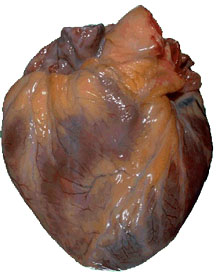 Prepared by
Prepared by
Diane Ball Linder, Ed D, LDN, RD
Page 3 of 4
Blood pressure
is a measure of that pressure taken at two stages. The
higher number, called the systolic pressure, is the pressure
exerted when the heart contracts and pumps blood through
the vessels. The lower number, called the diastolic pressure,
is the pressure exerted when the heart relaxes between beats.
|
|
High Blood Pressure (Hypertension)
 Hypertension contributes to nearly 1 million heart
attacks each year. Hypertension contributes to nearly 1 million heart
attacks each year.
Reducing hypertension has been shown to lower the incidence
of stroke, coronary heart disease and heart failure.
What is blood pressure?
Blood flowing through blood vessels creates a pressure against
the vessel wall. Blood pressure is a measure of that pressure
taken at two stages. The higher number, called the systolic
pressure, is the pressure exerted when the heart contracts and
pumps blood through the vessels. The lower number, called
the diastolic pressure, is the pressure exerted when the heart
relaxes between beats. Blood pressure rises when blood
vessels become narrow and hard, leaving less room for blood to
flow. The heart has to work harder to move the blood.
An optimal blood pressure reading is: 120 systolic/80 diastolic.
What are the classifications of blood pressure?
|
Optimal (good) |
120/80 |
|
Normal |
less than 130/85 |
|
High normal |
130-139/85-89 People in this
range are at high risk for
developing hypertension. Try to change your diet and exercise
first. If this doesn't work, see your doctor. |
|
Hypertension |
140-209/ 90-119 |
|
Very severe Hypertension |
209-above/ 119-above |
Blood pressure readings are not always the same. They
vary depending on physical activity, emotional state and
other factors. If your blood pressure reading is high
for a long period of time though, it becomes a medical concern.
What are the dangers of high blood pressure?
Uncontrolled high blood pressure can cause complications in
several bodily organs, including the heart, blood vessels, brain,
nerves, kidneys and retinas (eyes).
- 1. Enlargement of the heart: When blood
vessels are damaged, the heart must strain to meet the body's
need for blood and the oxygen that blood carries. Over time,
the heart will become enlarged and weak, leading to heart failure.
2. Atherosclerosis: High blood pressure can damage
the inner linings of the arteries, creating rough areas
where fatty deposits can build up. This condition is called
atherosclerosis or hardening of the arteries. When the
arteries harden, it is harder for the body to regulate blood
pressure.
3. Stroke: High blood pressure can damage vessels
that supply blood to the brain. Damaged blood vessels can
disrupt the flow of blood to the brain, causing a stroke.
4. Coronary heart disease (CHD): Coronary heart disease occurs when
the arteries that supply blood to the heart become blocked. Hypertension
is a CHD risk factor.
5. Kidney damage and failure: High blood pressure for a long time can
damage blood vessels in the kidneys, eventually leading to kidney
failure.
6. Eye damage: High blood pressure for a long time can damage blood
vessels on the retina, eventually leading to blindness if untreated.
What are some hypertension risk factors?
- 1. Aging: About 52% of Americans in their 60s' have
high blood pressure.
2. Family history: If one or both your parents
have high blood pressure, you have a greater chance of becoming
hypertensive.
3. Race: African-Americans have about twice the risk of developing
hypertension than do Caucasians.
4. Overweight or obese individuals: Overweight or obese individuals
have a higher risk of becoming hypertensive as individuals at
a healthy body weight.
What can you do?
- 1. Have your blood pressure measured by a health professional
every two years.
2. Keep your blood pressure under control: Less than 140/90.
3. If you have hypertension, take medication prescribed by your
doctor, maintain a healthy body weight, exercise regularly, cut
down on salt and quit smoking.
   [ LESSONS || SITE
MAP || LOCAL AGENTS || RESOURCES || PEOPLE ]
[ LESSONS || SITE
MAP || LOCAL AGENTS || RESOURCES || PEOPLE ]
 Issued in furtherance of Cooperative Extension
work, Acts of Congress of May 8 and June 30, 1914, in cooperation
with the United States Department of Agriculture. The Louisiana
Cooperative Extension Service provides equal opportunities in
programs and employment. Information and Graphics on this site
are copyright protected by LSU Agricultural Center's Louisiana Cooperative Extension Services.
For more information
on the EFNEP program, contact EFNEPMail@agcenter.lsu.edu. Issued in furtherance of Cooperative Extension
work, Acts of Congress of May 8 and June 30, 1914, in cooperation
with the United States Department of Agriculture. The Louisiana
Cooperative Extension Service provides equal opportunities in
programs and employment. Information and Graphics on this site
are copyright protected by LSU Agricultural Center's Louisiana Cooperative Extension Services.
For more information
on the EFNEP program, contact EFNEPMail@agcenter.lsu.edu.
|